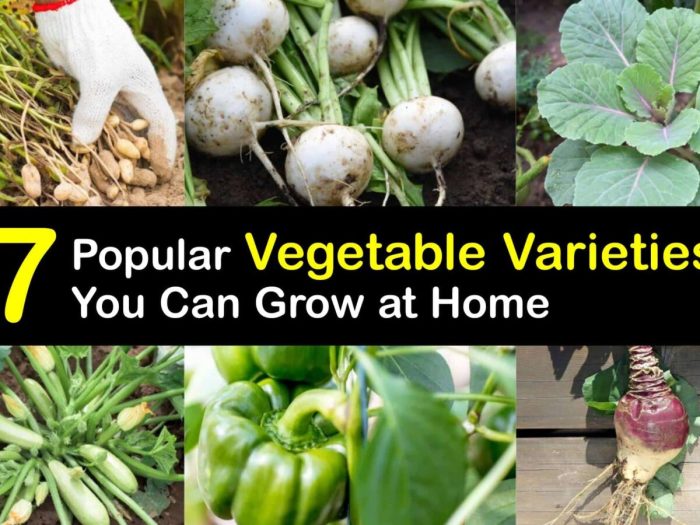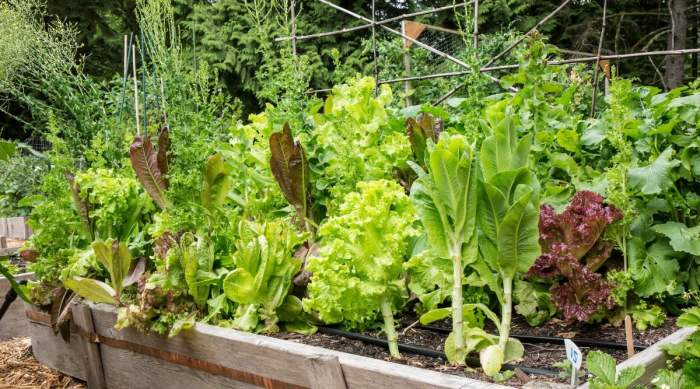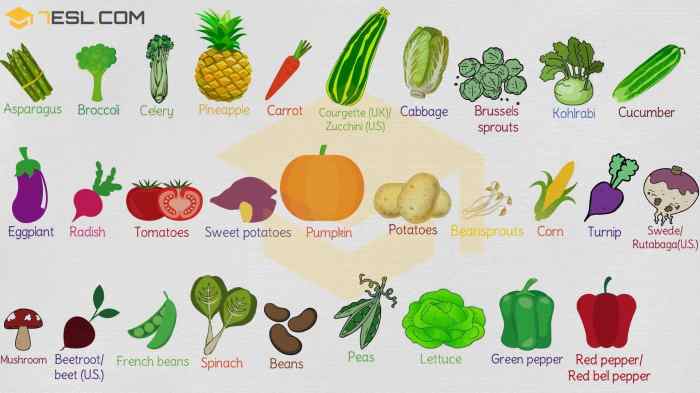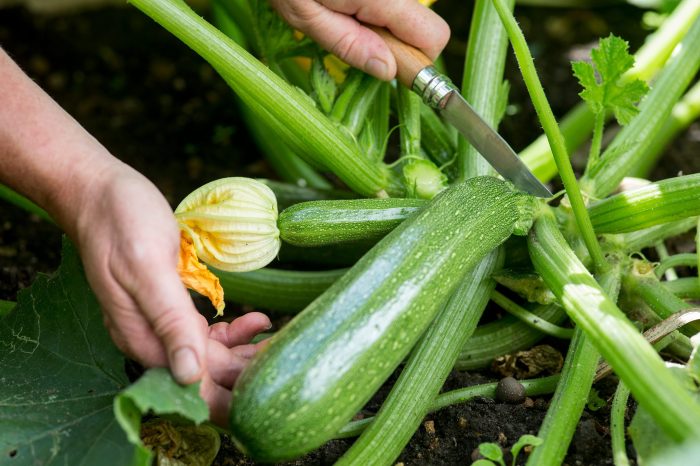How to Grow 10 Different Types of Vegetables opens the door to a world of gardening possibilities. From leafy greens to root vegetables, this guide provides valuable insights to help you cultivate a bountiful garden.
Types of Vegetables to Grow
When it comes to home gardening, there are various types of vegetables that you can grow to enjoy fresh produce right from your backyard. Here are 10 different types of vegetables that are suitable for home gardening:
1. Tomatoes
Tomatoes thrive in sunny locations with well-drained soil. They are rich in vitamins A and C, as well as lycopene, which is known for its antioxidant properties.
2. Carrots
Carrots prefer loose, sandy soil and plenty of sunlight. They are an excellent source of beta-carotene, which is essential for healthy vision.
3. Spinach
Spinach grows well in cool weather and requires moist soil. It is packed with iron, vitamins, and minerals, making it a nutritious addition to your diet.
4. Bell Peppers
Bell peppers need warm soil and plenty of sunlight to thrive. They are high in vitamin C and antioxidants, which help boost the immune system.
5. Zucchini
Zucchini plants do well in fertile soil and warm temperatures. They are low in calories but rich in vitamins and minerals, making them a healthy choice for your garden.
6. Cucumbers
Cucumbers require plenty of water and sunlight to grow. They are hydrating and contain vitamins K and C, which are beneficial for bone health and immunity.
7. Radishes
Radishes prefer cooler temperatures and well-drained soil. They are a good source of vitamin C and fiber, promoting digestion and overall health.
8. Lettuce
Lettuce grows best in cool, shaded areas with regular watering. It is low in calories but high in vitamins and minerals, making it a nutritious choice for salads.
9. Green Beans
Green beans thrive in well-drained soil and warm temperatures. They are rich in fiber and antioxidants, supporting digestive health and reducing inflammation.
10. Broccoli
Broccoli requires full sun and fertile soil to grow. It is a powerhouse of nutrients, including vitamins K and C, as well as fiber, which are essential for overall health.
Planning Your Vegetable Garden
When it comes to planning your vegetable garden, there are several key factors to consider to ensure a successful harvest. From selecting the right location to preparing the soil and organizing your plants, each step plays a crucial role in the growth and development of your vegetables.
Selecting the Right Location
- Choose a spot that receives ample sunlight throughout the day, as most vegetables require at least 6-8 hours of sunlight to thrive.
- Ensure the area has good drainage to prevent waterlogging, which can lead to root rot and other issues.
- Avoid areas with strong winds that can damage delicate plants or dry out the soil too quickly.
Preparing the Soil
- Test the soil pH and nutrient levels to determine if any amendments are needed to create an optimal growing environment for your vegetables.
- Loosen the soil to a depth of at least 12 inches to promote root growth and improve drainage.
- Incorporate organic matter such as compost or aged manure to enhance soil fertility and structure.
Organizing Your Garden
- Consider the mature size of each plant when spacing them out to prevent overcrowding and competition for resources.
- Group vegetables with similar water, sunlight, and nutrient requirements together to make maintenance easier.
- Use techniques like companion planting to maximize space and increase crop yield by planting mutually beneficial plants together.
Planting and Caring for Tomatoes

Tomatoes are a popular vegetable to grow in home gardens due to their versatility and delicious taste. Proper planting and care are essential to ensure a bountiful harvest of juicy tomatoes.
Planting Tomato Seeds or Seedlings
When planting tomatoes, you have the option to start from seeds or purchase seedlings from a nursery. If starting from seeds, sow them indoors 6-8 weeks before the last frost date in your area. Plant the seeds in a seed-starting mix, keep them warm, and ensure they receive plenty of light. Once the seedlings have grown to a few inches tall, they can be transplanted outdoors after the danger of frost has passed.
Watering and Fertilizing Requirements
Tomatoes require consistent watering to ensure they stay healthy and produce juicy fruits. Water them deeply but infrequently to encourage strong root growth. Avoid getting the foliage wet to prevent diseases. Additionally, tomatoes are heavy feeders and will benefit from regular fertilization. Use a balanced fertilizer or compost to provide essential nutrients for healthy growth.
Supporting and Pruning Tomato Plants
Tomato plants can become heavy with fruit, so it’s important to provide support to prevent them from bending or breaking. Stake or cage the plants to keep them upright and ensure proper air circulation. Pruning is also essential to promote better growth and fruit production. Remove any suckers that grow in the axils of the main stems to direct the plant’s energy towards fruit development.
Growing Leafy Greens
Growing leafy greens such as lettuce, spinach, and kale can be a rewarding experience for any gardener. These vegetables are packed with nutrients and are relatively easy to grow in your garden or containers.
Growing Process
To grow leafy greens, start by selecting a sunny spot with well-draining soil. Sow the seeds directly into the ground or containers, following the instructions on the seed packet for spacing and depth. Water regularly to keep the soil moist but not waterlogged. Leafy greens thrive in cooler temperatures, so consider planting them in early spring or late summer for best results.
Pest Control
One common pest that can affect leafy greens is aphids. To control aphids, you can spray the plants with a mixture of water and dish soap or use insecticidal soap. Another effective method is to introduce beneficial insects such as ladybugs or lacewings to your garden, as they prey on aphids and other pests.
Harvesting Practices
When harvesting leafy greens, it’s important to pick the outer leaves first, allowing the inner leaves to continue growing. This method promotes continuous growth and ensures a longer harvest period. Use clean scissors or shears to cut the leaves, avoiding any damage to the plant. Wash the harvested greens thoroughly before consuming or storing them in the refrigerator for later use.
Cultivating Root Vegetables
When it comes to cultivating root vegetables like carrots, radishes, and beets, it’s essential to pay attention to the specific needs of these plants. From planting to harvesting, each step plays a crucial role in the successful growth of these nutritious veggies.
Planting and Caring for Root Vegetables
Root vegetables thrive in well-drained soil with good depth and quality. Before planting, ensure the soil is loose and free of rocks or debris that may impede root growth. It’s recommended to amend the soil with organic matter like compost to provide essential nutrients for the vegetables.
- Carrots: Sow carrot seeds directly into the ground, ensuring they have enough space to grow without crowding. Keep the soil consistently moist to promote healthy root development.
- Radishes: Plant radish seeds in shallow soil and water regularly to prevent the roots from becoming woody. Harvest radishes promptly once they reach the desired size for the best taste.
- Beets: Plant beet seeds in well-drained soil and maintain consistent moisture levels throughout the growing season. Thin out seedlings to allow beets to reach their full size without competition.
Importance of Soil Depth and Quality
The depth and quality of the soil are critical factors for growing root vegetables successfully. Root vegetables like carrots and beets require deep soil to develop long, straight roots without obstruction. Additionally, soil quality directly impacts the flavor and nutrient content of these vegetables.
Good soil depth and quality are essential for root vegetables to grow healthy and flavorful.
Harvesting and Storing Root Vegetables
Harvest root vegetables like carrots, radishes, and beets when they have reached maturity. Use a garden fork to gently loosen the soil around the vegetables before pulling them out to prevent damage to the roots. After harvesting, remove any excess soil and store the vegetables in a cool, dark place to maintain freshness.
Caring for Bell Peppers and Chili Peppers: How To Grow 10 Different Types Of Vegetables
Growing bell peppers and chili peppers from seeds requires a few important steps to ensure successful growth. These plants thrive in warm climates and need adequate sunlight and water to produce healthy fruits.
Steps for Growing Bell Peppers and Chili Peppers from Seeds:
- Start seeds indoors 8-10 weeks before the last frost date in your area.
- Use a seed starting mix and plant seeds 1/4 inch deep in containers with drainage holes.
- Keep the soil moist but not waterlogged and place the containers in a warm, sunny location.
- Transplant seedlings outdoors after the danger of frost has passed, spacing them 18-24 inches apart.
Sunlight and Watering Requirements for Pepper Plants:
- Pepper plants require at least 6-8 hours of sunlight daily to thrive and produce fruits.
- Water pepper plants regularly, keeping the soil consistently moist but not soggy. Avoid overwatering to prevent root rot.
- Consider using mulch around the base of the plants to retain moisture and regulate soil temperature.
Common Issues and Diseases Affecting Pepper Plants:
- Blossom end rot: Caused by calcium deficiency or inconsistent watering, leading to black spots on the bottom of fruits.
- Aphids and whiteflies: Common pests that can affect pepper plants, causing yellowing leaves and stunted growth.
- Early blight: Fungal disease that causes dark spots on leaves and can spread to fruits, affecting overall plant health.
Planting and Harvesting Cucumbers

When it comes to planting and harvesting cucumbers, there are specific steps and considerations to keep in mind to ensure a successful harvest of these delicious fruits.To start growing cucumbers, you can either plant seeds directly in the ground or begin with seedlings that have been started indoors. If planting seeds, make sure to sow them in well-drained soil after the last frost date in your area.
Keep the soil consistently moist but not waterlogged to promote germination. For seedlings, transplant them into the garden once they have developed a few sets of true leaves. Be sure to space the plants at least 12-24 inches apart to allow for proper growth and airflow.
Support Structures for Growing Cucumber Plants
When growing cucumber plants, it is essential to provide them with support structures to help them climb and stay off the ground. This not only saves space in the garden but also prevents the fruits from rotting on the soil. One common method is to use trellises or stakes to train the cucumber vines to grow vertically. This helps improve air circulation around the plants and makes harvesting easier.
You can also use cages or A-frames for larger cucumber varieties that need more support.
Harvesting Cucumbers at the Right Time
Knowing when to harvest cucumbers is crucial to ensure they are at their peak flavor and texture. Cucumbers should be harvested when they are firm, green, and at least 6-8 inches long for slicing varieties. Pickling cucumbers are usually harvested when they are smaller, around 3-5 inches in length.To harvest cucumbers, gently twist them off the vine or use a pair of scissors to cut the stem.
Be careful not to damage the plant while harvesting, and try to harvest cucumbers in the morning when they are at their crispest.Overall, with proper planting techniques, support structures, and timely harvesting, you can enjoy a bountiful cucumber harvest from your garden.
Growing Zucchini and Squash

When it comes to growing zucchini and squash, it’s important to provide the ideal growing conditions for these plants to thrive. Both zucchini and squash are warm-season vegetables that require plenty of sunlight and well-drained soil to grow successfully.
Ideal Growing Conditions
- Plant zucchini and squash in a location that receives at least 6-8 hours of sunlight per day.
- Ensure the soil is rich in organic matter and well-drained to prevent waterlogging, which can lead to root rot.
- Maintain a soil pH level between 6.0 and 7.0 for optimal growth.
- Space the plants about 2-3 feet apart to allow for proper air circulation and prevent overcrowding.
- Water consistently, keeping the soil evenly moist but not waterlogged.
Preventing Common Problems
- To prevent powdery mildew in zucchini plants, avoid overhead watering and ensure good air circulation around the plants.
- Apply a fungicide early in the season as a preventive measure against powdery mildew.
- Remove and destroy any infected leaves to prevent the spread of the disease.
Harvesting Tips
- Harvest zucchinis and squash when they are small to medium in size for the best flavor and texture.
- Cut the fruits from the plant using a sharp knife or pruning shears to avoid damaging the plant.
- Harvest regularly to encourage continuous production throughout the growing season.
Cultivating Herbs in Your Garden
Herbs are a great addition to any garden, adding fresh flavors to your dishes and even providing medicinal benefits. Popular herbs like basil, mint, and parsley are easy to grow at home and require minimal maintenance.
Popular Herbs for Home Gardening
- Basil: Known for its aromatic leaves, basil is great for adding flavor to pasta dishes, salads, and even homemade pesto.
- Mint: Mint is a versatile herb that can be used in both sweet and savory dishes, as well as for making refreshing drinks like mojitos.
- Parsley: This herb is commonly used as a garnish but can also be added to soups, sauces, and salads for an extra burst of freshness.
Caring for and Propagating Herbs
- Ensure your herbs are planted in well-draining soil and receive plenty of sunlight.
- Water your herbs regularly, but be careful not to overwater as this can cause root rot.
- To propagate herbs, you can take cuttings from existing plants and root them in water before transferring them to soil.
Creative Ways to Use Fresh Herbs, How to Grow 10 Different Types of Vegetables
- Infuse olive oil with herbs like rosemary and thyme for a flavorful cooking oil.
- Add chopped herbs like cilantro and chives to your scrambled eggs or omelets for an extra kick of flavor.
- Create herb butter by mixing softened butter with finely chopped herbs like tarragon and dill, then refrigerate until firm.
Tips for Maintaining a Productive Vegetable Garden

Maintaining a productive vegetable garden requires ongoing care and attention to ensure healthy plant growth and abundant harvests. Here are some key tips to help you keep your garden flourishing:
Crop Rotation for Soil Health
Crop rotation is a vital practice to maintain soil health and prevent nutrient depletion. By alternating the types of vegetables grown in specific areas each season, you can help reduce soil-borne diseases, pests, and improve overall soil structure. For example, avoid planting the same family of vegetables in the same spot every year to minimize the risk of soil exhaustion and promote balanced nutrient levels.
Companion Planting Benefits
Companion planting involves growing different plants together to maximize growth, deter pests, and enhance flavor. For instance, planting marigolds near tomatoes can help repel nematodes, while growing basil near peppers can improve their flavor. Research companion planting combinations that work well for the vegetables in your garden to create a harmonious and beneficial ecosystem.
Organic Pest Control
Dealing with common garden pests organically is essential to protect your vegetables without harmful chemicals. Consider using natural pest control methods like handpicking insects, introducing beneficial insects such as ladybugs or praying mantises, and using homemade sprays with ingredients like neem oil or garlic. Regularly inspect your plants for signs of pests and take proactive measures to keep them at bay.
Last Word

In conclusion, mastering the art of growing different types of vegetables can be a rewarding experience. With the right knowledge and techniques, you can enjoy a thriving garden filled with fresh produce all year round.